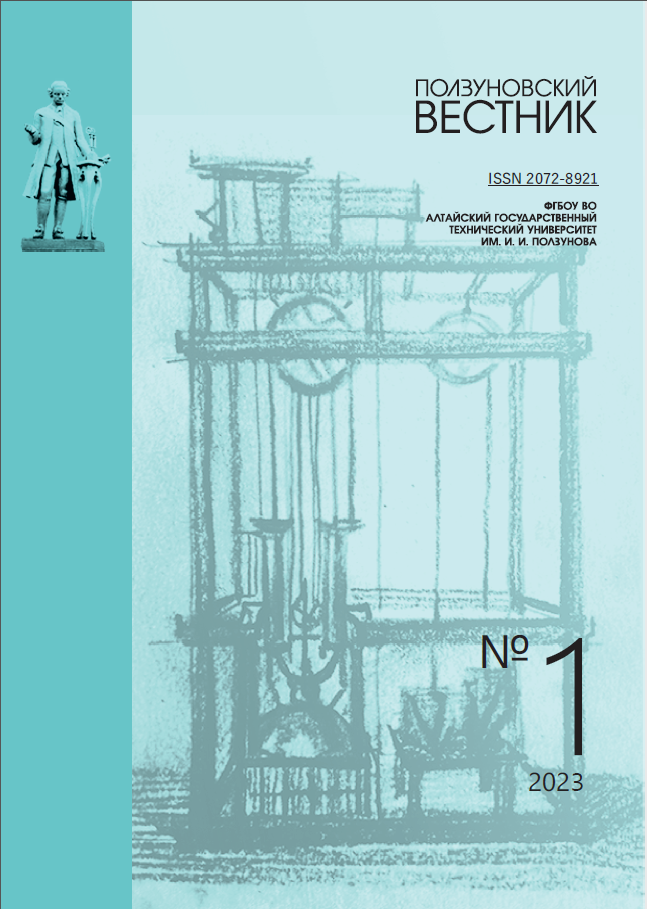ПОЛИПЕПТИД МОЛОЗИВА КОРОВ – ПЕРСПЕКТИВНЫЙ ФУНКЦИОНАЛЬНЫЙ ИНГРЕДИЕНТСПЕЦИАЛИЗИРОВАННОЙ ПИЩЕВОЙ ПРОДУКЦИИ ДЛЯ ПРОФИЛАКТИКИ ВИРУСНЫХ ИНФЕКЦИЙ
XQQEMB
DOI:
https://doi.org/10.25712/ASTU.2072-8921.2023.01.014Ключевые слова:
молочный белок, трипсин, ферментативный гидролизат, молозиво коров, биологически активные пептиды, противовирусная активность, интеграция вируса в геном, проникновение вируса через мембрану клетки, продукты специализированного назначения.Аннотация
Белок молозива коров и его фракции являются ценными источниками биоактивных пептидов с противовирусной активностью, что ценно для разработки новых пищевых продуктов профилактического назначения. Авторами проведены исследования поизучению влияния полипептида, выделенного из трипсинового гидролизата молозива коров, на интеграциюлентивирусных частиц в геном и проникновение в мембрану клеток. Полипептид, молекулярная масса которого составляет 18 кДа, состоит из 49 аминокислот.В качестве модельного объекта, на котором изучена противовирусная активность данного полипептида(mpT),были использованы клеточные линии C6 и HEK 293T. Анализ 2D- и 3D-пространственной структуры полипептида показал, что аминокислотные последовательности исследуемых образцов пептидов формируют вторичные структуры – преимущественно альфа-спираль. Изоэлектрическая точка полипептида находится в сильнощелочной среде (11,7), уровень гидрофильности соответствует +48,34 Ккал*моль-1. Высокая гидрофильность защищаетполипептид от опсонизации фаго- и эноцитоза. Трехмерная модель mpT позволила установить, что он обладает высокой химической активностью, так как его заряд (+6), что способствует усилению взаимодействия с атомами клетки и лизису вирусных ДНК и РНК. Полипептид mpT снижает эффективность трансдукции лентивирусных частицна 81 %. Интенсификация проникновения вируса через мембрану значительно снизилась, о чем свидетельствует снижение общего количества GFP внутри клетки. Статистическая обработка подтвердила, что при культивировании клетокпри температуре 37 ºС в значительной степени уменьшилось общее количество GFP внутри клетки при заражении вирусом. Полученные данные позволяют рекомендовать использовать исследуемый полипептид mpTв качестве функционального ингредиента в составе специализированной пищевой продукции для профилактики вирусных инфекций. Однако необходимо учитывать, что существует определенный пробел в знаниях в отношении токсичности, аллергенности, стабильности, биодоступности и эффективности биопептидов в составе продуктов специализированного назначения, особенно в экспериментах invivo, что свидетельствует о необходимостидополнительных исследований
Библиографические ссылки
Park, Y.W. &Nam, M.S. (2015). Bioactive peptides in milk and dairy products: A review. Korean Journal for Food Science of Animal Resources, 35 (6), 831–840,https://doi.org/10.5851/kosfa.2015.35.6.831.
Giacometti, J. &Buretić-Tomljanović, A. (2017). Peptidomics as a tool for characterizing bioactive milk peptides. Food Chemistry, 230, 91–98, https://doi. org/10.1016/j.foodchem.2017.03.016.
Homayouni-Tabrizi, M., Asoodeh, A. &Soltani, M. (2017). Cytotoxic and antioxidant capacity of camel milk peptides: Effects of isolated peptide on superoxide dismutase and catalase gene expression. Journal of Food and Drug Analysis, 25(3), 567–575,https://doi.org/10.1016/j.jfda.2016.10.014.
Kocak, A., Sanli, T., Anli, E.A. &Hayaloglu, A.A. (2020). Role of using adjunct cultures in release of bioactive peptides in white-brined goat-milk cheese. Lwt, 123(February), 109127,https://doi.org/10.1016/j.lwt.2020.109127.
Buttar, H.S., Bagwe, S.M., Bhullar, S.K. & Kaur, G. (2017). Health benefts of bovine colostrum in children and adults. Academic.3–20, https://doi.org/10.1016/B978-0-12-809868-4.000017.
Gruden,Š.,Poklar, U. Diverse Mechanisms of Antimicrobial Activities of Lactoferrins, Lactoferricins, and Other Lactoferrin-Derived Peptides. Int J Mol Sci. 2021;22(20):11264.
Sienkiewicz, M., Szymańska, P. &Fichna, J. (2021). Supplementation of bovine colostrum in infammatory bowel disease: Benefts and contraindications. AdvancesinNutrition, 12 (2), 533–545.
Wakabayashi, H., Oda, H., Yamauchi, K. & Abe, F. (2014). Lactoferrin for prevention of common viral infections. Journal of Infection and Chemotherapy, 20 (11), 666–671,https://doi.org/10.1016/j.jiac.2014.08.003 PMID: 25182867.
Silva, E., Rangel, A., Mürmam, L., Bezerra, M.F. & Oliveira, J.P.F.D. (2019). Bovine colostrum: Benefts of its use in human food. Food Science and Technology, 39, 355–362, https://doi.org/10.1590/fst.14619.
Ibrahim, H.R., Isono, H. & Miyata, T. (2018). Potential antioxidant bioactive peptides from camel milk proteins. Animal Nutrition, 4(3), 273–280, https://doi. org/10.1016/j.aninu.2018.05.004.
Kumar, D., Chatli, M.K., Singh, R., Mehta, N. & Kumar, P. (2016). Antioxidant and antimicrobial activity of camel milk casein hydrolysates and its fractions. Small Ruminant Research, 139, 20–25,https://doi.org/10.1016/j.smallrumres.2016.05.002.
Brice, D.Diamond, G. (2020).Antiviral Activities of Human Host Defense Peptides. CurrMed-Chem.;27 (9):1420-1443.
Heydari, H, Golmohammadi, R., Mirnejad, R., Tebyanian, H., Fasihi-Ramandi, M.Moghaddam, M. (2021). Antiviral peptides against Coronaviridae family: A re-view. Peptides.139. 170526.
Fu,Y., Jaarsma, A.H. Kuipers, O.P. (2021). Antiviral activities and applications of ribosomally synthesized and post-translationally modified peptides (RiPPs). Cell Mol Life Sci.;78(8):3921-3940.
Ashaolu, T., Nawaz, A., Walayat, N.Khalifa, I. (2021). Potential "biopeptidal" therapeutics for severe respiratory syndrome coronaviruses: a review of antiviral peptides, viral mechanisms, and prospective needs. ApplMicrobiolBiotechnol.105(9). 3457-3470.
Zannella, C., Chianese, A., Palomba, L., et al. (2022). Broad-Spectrum Antiviral Activity of the Amphibian Antimicrobial Peptide Temporin L and Its Analogs. Int J MolSci.23(4). 2060.
Hoffmann, A.R., Guha, S, Wu, E., et al. (2020). Broad-Spectrum Antiviral Entry Inhibition by Interfacially Active Peptides. J Virol.94(23).e01682-20.
Vanzolini, T., Bruschi, M., Rinaldi, A.C., Magnani, M, Fraternale, A. (2022). Multitalented Synthetic Antimicrobial Peptides and Their Antibacterial, Antifungal and Antiviral Mechanisms. Int J Mol Sci.;23(1):545.
Zarzosa-Moreno, D., Avalos-Gómez, C., Ramírez-Texcalco, L., et al. (2020). Lactoferrin and Its Derived Peptides: An Alternative for Combating Virulence Mechanisms Developed by Pathogens. Molecules.25(24).5763.
Wang, T., Fang, X., Wen, T., et al. (2021). Synthetic Neutralizing Peptides Inhibit the Host Cell Binding of Spike Protein and Block Infection of SARS-CoV-2. JMedChem. 64(19). 14887-14894.
Загрузки
Опубликован
Как цитировать
Выпуск
Раздел
Лицензия
Copyright (c) 2023 Сергей Леонидович Тихонов,Ирина Михайловна Чернуха

Это произведение доступно по лицензии Creative Commons «Attribution» («Атрибуция») 4.0 Всемирная.
















 .
. Контент доступен под лицензией
Контент доступен под лицензией 
